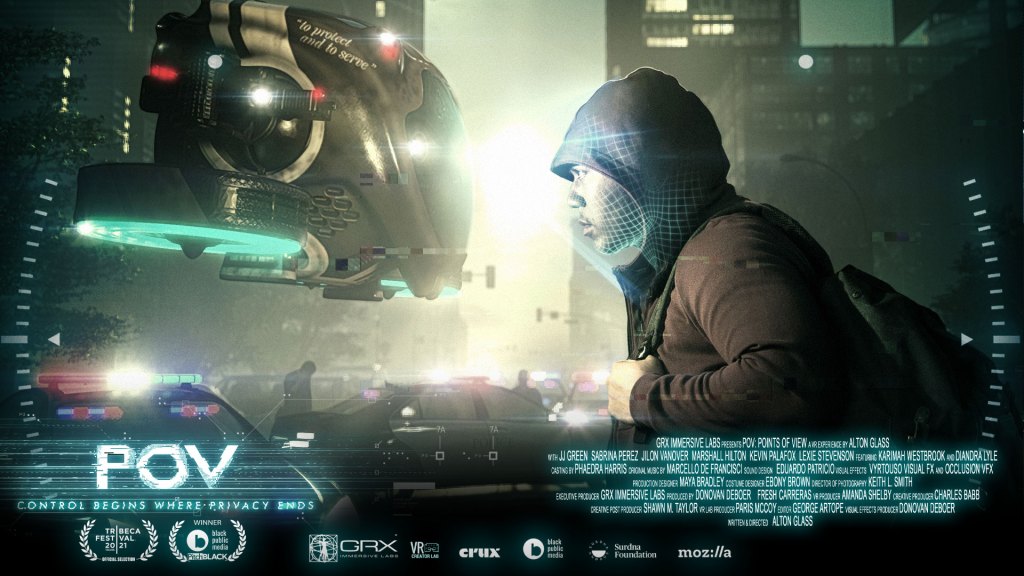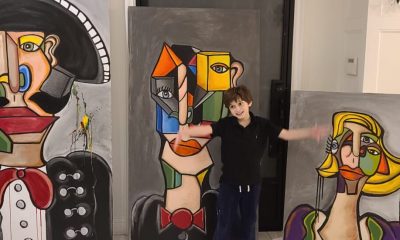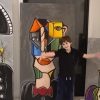ART WORLD NEWS
Alton Glass on Bringing Black Representation to VR – ARTnews.com
Alton Glass first got into VR when he was placed in a NASCAR simulation. “When they put me in the pit with these big cars driving by it blew me away,” the movie director, best known for Cru (2014), said. “I actually got a chance to experience that.” After that, Glass fell down the rabbit hole of VR captured by the immersiveness it promised audiences. In 2008, he founded GRX Immersive Labs to do research and development on the new technology, the Lab now also functions as a creative technology studio. With the support of the Youtube VR Creative Lab and his follow artists, he was able to make his short film POV: Points of View (2018) which is on view now at Tribeca Immersive.
Related Articles
Shot on tight budget, Glass’s POV tried to imagine a less dystopian view of the future where drone technology and predictive policing can be used to reduce lethal confrontations between police and suspects. POV is set in 2025 as police departments are beginning to introduce drone technology. Cops aren’t the only characters in Glass’s film. The story follows a young Black coder, Cassius, who has just been paroled from prison. His release is conditioned upon the his being monitored by a drone. Ostensibly, the drone is present to protect others from Cassius. But the film reaches its climax when Cassius and a friend end up in a senseless confrontation with cops. The situation escalates culminating in gunfire. In our world, that encounter would end up with a Cassius dead. But in Glass’s fictive world, the drone has deployed rubber bullets to non-lethally prevent the officer from making a fatal mistake.
ArtNews got on the phone with Alton Glass to discuss the whiteness of VR, making immersive films on a shoestring budget, and his techno-optimism.
ARTnews: You used to be a movie director before getting into VR direction – how does the work differ?
Alton Glass: That was difficult [adjusting], as a director you’re so used to directing your viewers attention, look here, look there. It was challenging but that was something that I loved about it. How can I take my pre-existing storytelling capabilities and expand them out, expand the world? That’s what took me on a journey of understanding how to choreograph the viewers attention and how to build worlds that are other levels of world building.
ARTnews: How did you first get interested in VR?
Alton Glass: When I was younger I used to watch NASCAR races, that was my version of video games. When someone actually showed me a VR experience it was actually a NASCAR race [simulation]. When they put me in the pit with these big cars driving by it blew me away that I actually got a chance to experience that. I inquired [with the people behind the project] “Is there any way that I can learn more about this?” and they told me to go to this VR expo in LA and that’s when I had the opportunity to explore all types of VR experiences, learn about the technology, and start to really see entertainment and technology coming together.
ARTnews: Why did you found GRX Immersive?
Alton Glass: When I started in VR the barrier to entry was extremely high. I had a concept I wanted to make that was probably like 5 or 10 minutes long and I was told it would cost over $200,000. It was just 360 video and at the time post production was really expensive and there was not a lot of information out there, just kind of put yourself. So I transitioned my company into a research and development lab dedicated to understanding immersive storytelling, merging technology and entrepreneurship because you had to kind of pull yourself up by your bootstraps and figure it out. Then I invested in working with this organization called Radiant Images, spending time with their lab at their studio running equipment, hiring people to help them to understand how to use the equipment. I just tried to do a deep dive and that took me about two years. Then I landed my first job in Nashville and it just continued to grow from there.
ARTnews: VR is a pretty white dominated field, how do you think that lack of representation is affecting the way VR is being introduced to audiences?
That [lack of representation] was probably one of the biggest issues that I dealt with in traditional film and television. Outside of independent filmmaking there was very limited diversity, right, but with XR there was even more of a barrier, so I dedicated GRX to the advancement of voices, diverse voices in immersive storytelling. When I went to that first expo I didn’t see much representation there, then I started doing research on all the investments being made in the immersive economy, which at the time was just VR and AR, and then I started to see that economy growing, but I still didn’t see representation behind founders, creators, storytellers, developers.
But when I got into a program called Oculus Launchpad, I entered this nice space where I started to actually meet people who come from multiple disciplines and there was a lot of diversity. We started to build together, started to create together. Being able to work with organizations like Facebook meant that we were able to actually go out and teach HBCUs about immersive storytelling and entrepreneurship. Since I started six or seven years ago I’ve seen so many people come through, it’s been great to be able to see more and more people come in here into the immersive space, changing the landscape and bringing in new diverse experiences. Tribeca did a great job with that.
ARTnews: What was the main inspiration behind Points of View?
Alton Glass: I saw that video of Tamir Rice, unfortunately a young teenager, when he was gunned down by police because he had a toy gun. I was like “Wow, what if instead of putting all this money into the militarization of police we could re imagine public safety?” So we used this grant funding to create this concept of what it would be like if there were drones being used in law enforcement and we could see how they were learning to make decisions, and maybe see how a young person who’s on the other side of the penal system to get a second chance in this futuristic world. I started to dig deeper into understanding what AI was, what predictive policing is, how implicit bias works in tech and how this tech is advancing.
ARTnews: Now that you bring up these kinds of biases, predictive policing – why did you land on this optimistic conclusion?
Alton Glass: Well I wanted to show both sides, I didn’t want to demonize any of the characters or the technology in the world. The bigger question is, who is the person deciding what the problem is? How is that technology learning or how is the algorithm being programmed? I wanted to show a different perspective on what that technology could be used for. And then what was your point of view, beyond that, if this was. It’s open ended, how we can see this technology being used. This is just one use case of what could happen, against all of the other cases that we’ve seen where we’ve come out on the short end of the stick, as African American men and women, as it relates to policing.
ARTnews: What was the process like?
Alton Glass: I got into the YouTube VR Creative lab and they gave us some funding to do a prototype for a camera they were testing, a 180 VR camera. So our goal was to experiment with that tech by using the drones point of view. You can’t shoot 360 on camera because you’ll see the technicians behind the camera so we decided to put a 220 degree fisheye lens on a traditional cinema camera, like the Red camera, because that was something that I was used to using coming from my traditional film background. We wanted to get that cinematic latitude that we were used to getting but then we also found this great rig at another expo called the antigravity rig. It creates a steadycam movement, but it allows you to go beyond just the traditional steadycam can offer. You can get this sort of drone-like movement where you’re floating up high or down low to the ground, left to right. So that was our camera technology. We used a program called LogMeIn which is like architecture design software to create the immersive effect and then we shot on green screen. We do a lot of visual effects shots, which I had to learn the hard way, but I learned a lot and we experimented a ton and were able to come away with something great even though we just had a $40,000 budget. The running joke was we tried to make Avatar on a Clerks budget.
ARTnews: Really, just $40,000?
Yeah, nothing. I gotta give a shout out to all the favors I called in from all of my friends and collaborators. It was a labor of love. And like I said we made this three years ago, so now our understanding of how to use these tools is so much more and I just can’t wait to see what we’ll be able to do as a team with the resources we have now. Hopefully this can inspire some people to get out and do it. Maybe don’t worry about some of those barriers to entry, it’s possible to tell an impactful story with the resources you have.











